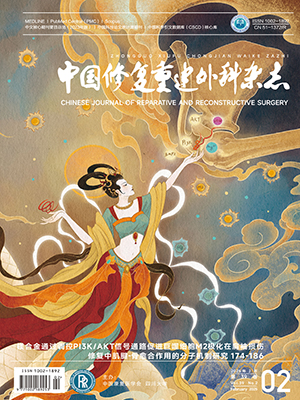| 1. |
许建中. 骨组织工程相关研究新进展. 中国修复重建外科杂志, 2010, 24(7):769-773.
|
| 2. |
Zhao L, Zhao JL, Wan L, et al. The study of the feasibility of segmental bone defect repair with tissue-engineered bone membrane:a qualitative observation. Strategies Trauma Limb Reconstr, 2008, 3(2):57-64.
|
| 3. |
杨志明. 组织工程. 北京:化学工业出版社, 2002:225-227.
|
| 4. |
范伟, 安洪, 蒋电明, 等. 脱蛋白骨为支架材料体外构建的组织工程骨. 中华医学杂志, 2006, 86(47):3349-3352.
|
| 5. |
Lane JM, Sandhu HS. Current approaches to experimental bone grafting. Orthop Clin North Am, 1987, 18(2):213-225.
|
| 6. |
贝抗胜, 吴礼杨, 孙庆文, 等. 人骨膜细胞生物学特性的实验研究. 中华创伤骨科杂志, 2011, 13(12):1170-1174.
|
| 7. |
李卫国, 黄向红, 唐景清, 等. 骨膜成骨细胞培养活体自体、异体和异种移植成骨的实验研究. 昆明医学院学报, 2008, 29(1):81-84.
|
| 8. |
Soldado F, Fontecha CG, Barber I, et al. Vascularized fibular periosteal graft:a new technique to enhance bone union in children. J Pediatr Orthop, 2012, 32(3):308-313.
|
| 9. |
吴伟炽, 黄东, 刘晓春, 等. 穿支骨膜瓣游离移植治疗难治性骨不连的疗效观察. 现代医院, 2013, 13(3):39-41.
|
| 10. |
赵琳, 史志勇, 周晟, 等. 组织工程骨膜异体体内成骨修复兔骨缺损的初步观察. 中国修复重建外科杂志, 2008, 22(2):145-147.
|
| 11. |
Muschler GF, Nakamoto C, Griffith LG. Engineering principles of clinical cell-based tissue engineering. J Bone Joint Surg (Am), 2004, 86-A(7):1541-1558.
|
| 12. |
王金成, 李志洲, 陈伟, 等. 骨库骨的生物力学特性比较研究. 骨与关节损伤杂志, 2001, 16(1):35-36.
|
| 13. |
简月奎, 罗阳, 田晓滨, 等. 改良法制备异种脱蛋白骨体内植入修复骨缺损的免疫学分析. 中国组织工程研究与临床康复, 2010, 14(42):7802-7806.
|




